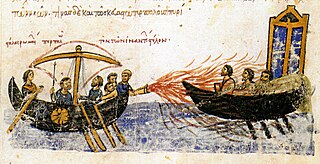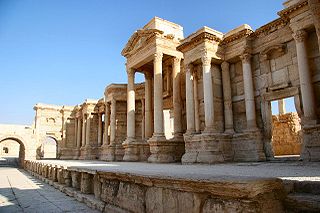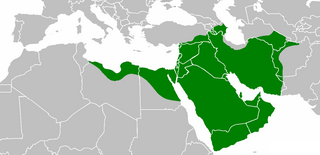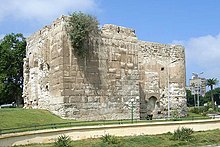John of Nikiû was an Egyptian Coptic bishop of Nikiû (Pashati) in the Nile Delta and general administrator of the monasteries of Upper Egypt in 696. He is the author of a Chronicle extending from Adam to the end of the Muslim conquest of Egypt. John of Nikiû's Chronicle contains important historical details otherwise unknown.

The Arab–Byzantine wars were a series of wars between a number of Muslim-Arab dynasties and the Byzantine Empire from the 7th to the 11th century. Conflict started during the initial Muslim conquests, under the expansionist Rashidun and Umayyad caliphs, in the 7th century and continued by their successors until the mid-11th century.

The Arab conquest of Egypt, led by the army of 'Amr ibn al-'As, took place between 639 and 646 AD and was overseen by the Rashidun Caliphate. It ended the seven-century-long period of Roman reign over Egypt that began in 30 BC. Byzantine rule in the country had been shaken, as Egypt had been conquered and occupied for a decade by the Sasanian Empire in 618–629, before being recovered by the Byzantine emperor Heraclius. The caliphate took advantage of Byzantines' exhaustion and captured Egypt ten years after its reconquest by Heraclius.

The early Muslim conquests or early Islamic conquests, more commonly known as the Arab conquests, were initiated in the 7th century by Muhammad, the main Islamic prophet. He established a new unified polity in Arabia that expanded rapidly under the Rashidun Caliphate and the Umayyad Caliphate, culminating in Islamic rule being established across three continents. According to Scottish historian James Buchan: "In speed and extent, the first Arab conquests were matched only by those of Alexander the Great, and they were more lasting."
Pope Benjamin I of Alexandria, 38th Pope of Alexandria & Patriarch of the See of St. Mark. He is regarded as one of the greatest patriarchs of the Coptic Church. Benjamin guided the Coptic church through a period of turmoil in Egyptian history that included the fall of Egypt to the Sassanid Empire, followed by Egypt's reconquest under the Byzantines, and finally the Arab Islamic Conquest in 642. After the Arab conquest Pope Benjamin, who was in exile, was allowed to return to Alexandria and resume the patriarchate.

The Muslim conquest of the Maghreb was a series of three invasions by which the Rashidun and Umayyad Caliphates took control of lands formerly comprising Byzantine North Africa, which was at that point organised as the Exarchate of Africa. It commenced in 647 and concluded in 709, when the Byzantine Empire lost its last remaining strongholds to Caliph Al Walid Ibn Abdul Malik. The North African campaigns were part of the century of rapid Muslim conquests which followed the death of Muhammad in 632.

The Battle of Nikiou was a battle between Arab Muslim troops under General Amr ibn al-A'as and the Byzantine Empire in Egypt in May of 646.

The Battle of Heliopolis or Ayn Shams was a decisive battle between Arab Muslim armies and Byzantine forces for the control of Egypt. Though there were several major skirmishes after this battle, it effectively decided the fate of the Byzantine rule in Egypt, and opened the door for the Muslim conquest of the Byzantine Exarchate of Africa.

Islamic rule in Tripolitania and Cyrenaica began as early as the 7th century. With tenuous Byzantine control over Libya restricted to a few poorly defended coastal strongholds, the Arab invaders who first crossed into Pentapolis, Cyrenaica in September 642 encountered little resistance. Under the command of Amr ibn al-A'as, the armies of Islam conquered Cyrenaica, renaming the Pentapolis, Barqa.

The Muslim conquest of the Levant, or Arab conquest of Syria, was a 634–638 CE invasion of Byzantine Syria by the Rashidun Caliphate. A part of the wider Arab-Byzantine Wars, the Levant was brought under Arab Muslim rule and developed into the provincial region of Bilad al-Sham. Clashes between the Arabs and Byzantines on the southern Levantine borders of the Byzantine Empire had occurred during the lifetime of Muhammad, with the Battle of Muʿtah in 629 CE. However, the actual conquest did not begin until 634, two years after Muhammad's death. It was led by the first two Rashidun caliphs who succeeded Muhammad: Abu Bakr and Umar ibn al-Khattab. During this time, Khalid ibn al-Walid was the most important leader of the Rashidun army.

Umar was the second Rashidun Caliph and reigned during 634–644. Umar's caliphate is notable for its vast conquests, aided by brilliant field commanders, he was able to incorporate present day Iraq, Iran, Azerbaijan, Armenia, Georgia, Syria, Jordan, Palestine, Lebanon, Egypt, and part of Afghanistan, Turkmenistan and south western Pakistan into the Caliphate. During his reign, the Byzantines lost more than three fourths of their territory and in Persia, and Umar was the king (ruler) of the Sassanid Empire before it ceased to exist.

The Rashidun Caliphate was the first caliphate to succeed the Islamic prophet Muhammad. It was ruled by the first four successive caliphs of Muhammad after his death in 632 CE. During its existence, the empire was the most powerful economic, cultural, and military force in West Asia.

Coptic history is the part of the history of Egypt that begins with the introduction of Christianity in Egypt in the 1st century AD during the Roman period, and covers the history of the Copts to the present day. Many of the historic items related to Coptic Christianity are on display in many museums around the world and a large number is in the Coptic Museum in Coptic Cairo.
Oriental Orthodoxy is the communion of Eastern Christian Churches that recognize only three ecumenical councils—the First Council of Nicaea, the First Council of Constantinople and the Council of Ephesus. They reject the dogmatic definitions of the Council of Chalcedon. Hence, these Churches are also called Old Oriental Churches or Non-Chalcedonian Churches.
'Ubadah ibn al-Samit was a companion of Muhammad and a well-respected chieftain of the Ansar tribes confederation. He participated in almost every battle during Muhammad's era. His official title, according to Muslim scholarly tradition, was 'Ubadah bin Saamit al-Ansari al-Badri for his actions at the Battle of Badr. He served under the first three Rashidun caliphs in the Muslim conquest against the Byzantines.
The Islamization of Egypt occurred after the 7th century Arab conquest of Egypt, in which the Islamic Rashidun Caliphate seized control of Egypt from the Christian Byzantine Empire. Egypt and other conquered territories in the Middle East underwent a large scale gradual conversion from Christianity to Islam, accompanied by jizya for those who refused to convert. Islam became the dominant faith by the 10th to 12th centuries, and Arabic replaced Coptic as the vernacular language and Greek as the official language.

ʿAmr ibn al-ʿĀṣ al-Sahmī was the Arab commander who led the Muslim conquest of Egypt and served as its governor in 640–646 and 658–664. The son of a wealthy Qurayshite, Amr embraced Islam in c. 629 and was assigned important roles in the nascent Muslim community by the Islamic prophet Muhammad. The first caliph Abu Bakr appointed Amr as a commander of the conquest of Syria. He conquered most of Palestine, to which he was appointed governor, and helped lead the Arabs to decisive victories over the Byzantines at the battles of Ajnadayn and Yarmouk in 634 and 636.
Agnou was an ancient city and bishopric in Egypt. It was located on the strip of land between the lake Burullus and the Mediterranean Sea, near the modern village al-Hanafi al-Kubra.
The Battle of Sufetula took place in 647 between the Arab Muslim forces of the Rashidun Caliphate and the Byzantine Exarchate of Africa.

The Babylon Fortress, a major military stronghold of the Byzantine Empire in Egypt, was captured by forces of the Rashidun Caliphate after a prolonged siege in 640. It was a major event during the Muslim conquest of Egypt.














